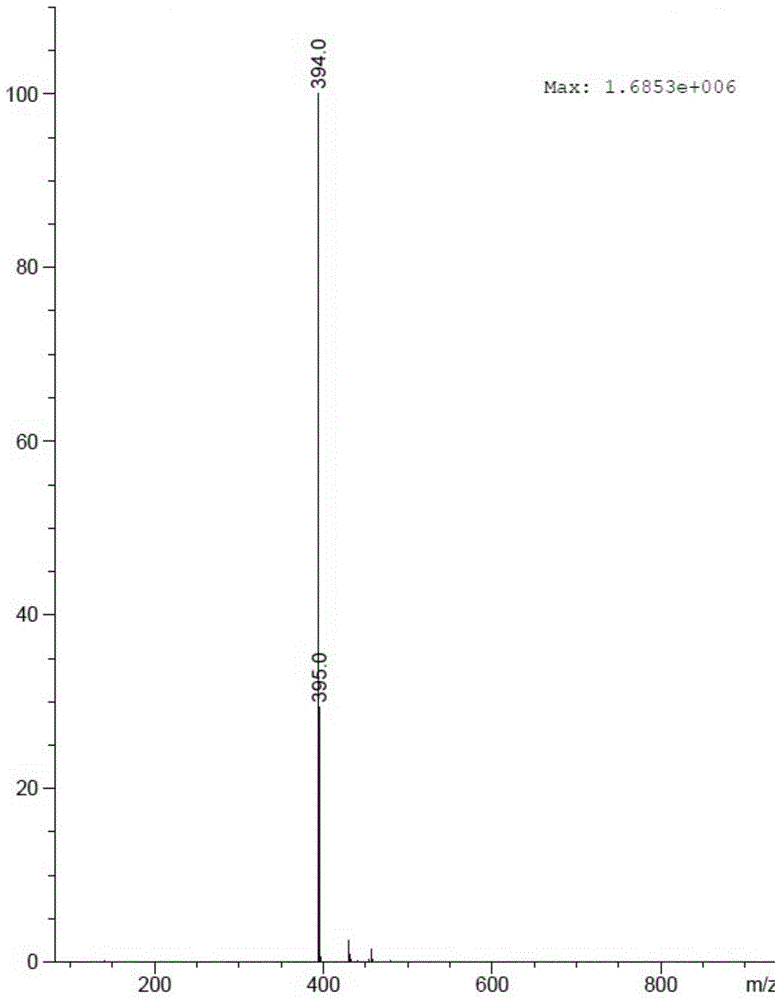Preparation method for erlotinib hydrochloride impurity
A technology for erlotinib hydrochloride and impurities, applied in the field of medicinal chemistry, can solve problems such as no public reports, and achieve the effects of improving quality standards, short synthesis routes, and simple operations
- Summary
- Abstract
- Description
- Claims
- Application Information
AI Technical Summary
Problems solved by technology
Method used
Image
Examples
Embodiment 1
[0025] Step (1): In a 5ml reaction flask, add 100mg of 6,7-bis-(2-methoxyethoxy)-4(3H)-quinazolinone, 240mg of thionyl chloride and 2ml of toluene in sequence, Slowly heat up to 50°C under stirring, the reaction lasts for 3h under stirring, then turn off the heating, and cool to room temperature under stirring, then add 1ml of water to the reactor to quench the reaction, separate the organic layer and use saturated chlorinated Wash it with sodium aqueous solution, dry it with anhydrous sodium sulfate, and finally concentrate to obtain 102 mg of a light yellow solid. After identification, the main component of the light yellow solid is 4-chloro-6,7-bis-(2-methoxy Ethoxy)-quinazoline, the yield is 96%;
[0026] Step (2): In a 5ml reaction bottle, add 100mg of 4-chloro-6,7-bis-(2-methoxyethoxy)-quinazoline and 76mg of m-amino Styrene and 3ml of ethyl acetate were slowly heated to 70°C under stirring, the reaction was continued for 3 hours under stirring, then the heating was tur...
Embodiment 2
[0029] Step (1): In a 25ml reaction flask, add 1.00g of 6,7-bis-(2-methoxyethoxy)-4(3H)-quinazolinone, 2.59g of oxalyl chloride and 15ml of tetrahydrofuran in sequence, Slowly heat up to 65°C under stirring, the reaction is continued for 3h under stirring, then turn off the heating, and cool to room temperature under stirring, then add 1ml of water to the reactor to quench the reaction, separate the organic layer and use saturated chlorinated Wash it with an aqueous sodium solution, dry it with anhydrous sodium sulfate, and finally concentrate to obtain 1.34 g of a light yellow solid. After identification, the main component of the light yellow solid is 4-chloro-6,7-bis-(2-methyl Oxyethoxy)-quinazoline, the yield is 97%;
[0030] Step (2): In a 25ml reaction bottle, add 1.00g of 4-chloro-6,7-bis-(2-methoxyethoxy)-quinazoline and 1.12g obtained in step (1) successively m-aminostyrene and 20ml of toluene, slowly heated up to 120°C under stirring, the reaction was continued for ...
Embodiment 3
[0036] Step (1): In a 250ml reaction flask, add 10g of 6,7-bis-(2-methoxyethoxy)-4(3H)-quinazolinone, 20.8g of phosphorus oxychloride and 200ml of toluene in sequence , slowly heated up to 80°C under stirring, the reaction was continued for 3h under stirring, then the heating was turned off, and cooled to room temperature under stirring, then 50ml of water was added to the reactor to quench the reaction, the organic layer was separated and washed with saturated chlorine Wash it with sodium chloride aqueous solution, dry it with anhydrous sodium sulfate, and finally concentrate to obtain 10.2 g of a light yellow solid. After identification, the main component of the light yellow solid is 4-chloro-6,7-bis-(2- Methoxyethoxy)-quinazoline, the yield is 96%;
[0037] Step (2): In a 250ml reaction bottle, add 10g of 4-chloro-6,7-bis-(2-methoxyethoxy)-quinazoline obtained in step (1) and 7.49g of Aminostyrene and 200ml of ethanol are slowly heated to 60°C under stirring, the reaction...
PUM
 Login to View More
Login to View More Abstract
Description
Claims
Application Information
 Login to View More
Login to View More - R&D
- Intellectual Property
- Life Sciences
- Materials
- Tech Scout
- Unparalleled Data Quality
- Higher Quality Content
- 60% Fewer Hallucinations
Browse by: Latest US Patents, China's latest patents, Technical Efficacy Thesaurus, Application Domain, Technology Topic, Popular Technical Reports.
© 2025 PatSnap. All rights reserved.Legal|Privacy policy|Modern Slavery Act Transparency Statement|Sitemap|About US| Contact US: help@patsnap.com



